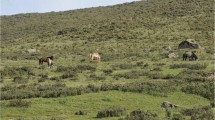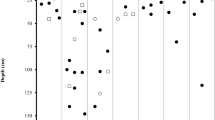Abstract
Forest edges with diverse vegetation are an important feature of habitat preference for the hazel dormouse Muscardinus avellanarius. Therefore, this study was conducted to determine the factors predicting summer nest construction in deciduous woodland edges in Slovakia. At the same time, nest types, dimensions of nests and nest-site preference in shrubs and young trees were analysed. A total of 178 summer nests were found over the years 2010–2013 on the branches of several plant species, but mainly on Prunus spinosa, Rubus fruticosus and Carpinus betulus. The principle component analysis (PCA) in this study revealed that several factors were significant for the construction of nests in shrubby vegetation. The occurrence of four nest types (mixed, layered, foliar and grassy) with relatively large dimensions was confirmed. Botanical analysis of the leaf material in the nests confirmed that ten different plant species were incorporated into the nests. Moreover, a positive correlation was shown between the distance of the nest from the ground and from the top of the plant and the plant height. This study suggests that this micro-habitat may play an important role for suitable nesting of the hazel dormouse, as stated by several authors from the different countries and regions of its large distributional range. At the same time, data on the presence or absence of summer nests in the monitored habitat aid in the detection of species.
Similar content being viewed by others
References
Berg L. & Berg Å. 1998. Nest site selection by the dormouse Muscardinus avellanarius in two different landscapes. Ann. Zool. Fenn. 35 (2): 115–122.
Berg L. & Berg Å. 1999. Abundance and survival of the hazel dormouse Muscardinus avellanarius in a temporary shrub habitat: a trapping study. Ann. Zool. Fenn. 36 (3): 159–165.
Bright P.W. & Morris P.A. 1991. Ranging and nesting behaviour of the dormouse, Muscardinus avellanarius, in diverse lowgrowing woodland. J. Zool. (Lond.) 224 (2): 177–190. DOI: 10.1111/j.1469-7998.1991.tb04797.x
Bright P.W. & Morris P.A. 1992. Ranging and nesting behaviour of the dormouse, Muscardinus avellanarius, in coppice-with-standards woodland. J. Zool. (Lond.) 226 (4): 589–600. DOI: 10.1111/j.1469-7998.1992.tb07502.x
Čanády A. 2012. Príspevok k poznatkom o výskyte myšky drobnej (Micromys minutus) a plcha lieskového (Muscardinus avellanarius) na východnom Slovensku na základe letných hniezd za roky 2010–2012 (Rodentia) [Contribution to knowledge of the harvest mouse (Micromys minutus) and hazel dormouse (Muscardinus avellanarius) distribution in East Slovakia on the base of summer nests (2010–2012).] Lynx (Praha) n.s. 43 (1–2): 5–15.
Čanády A. 2013. Nest dimensions and nest sites of the harvest mouse (Micromys minutus Pallas, 1771) from Slovakia: a case study from field margins. Zoology and Ecology 23 (4): 253–259. DOI: http://dx.doi.org/10.1080/21658005.2013.853492
Hata S. 2011. Nesting characteristics of harvest mice (Micromys minutus) in three types of Japanese grasslands with different inundatin frequencies. Mammal Study 36 (1): 49–53. DOI: http://dx.doi.org/10.3106/041.036.0106
Juškaitis R. 2004. Local impact of the Tawny owls (Strix aluco) on the common dormice (Muscardinus avellanarius) in Lithuania. Ekológia (Bratisl.) 23 (3): 305–309.
Juškaitis R. 2008. The Common Dormouse Muscardinus avellanarius: Ecology, Population Structure and Dynamics. Institute of Ecology of Vilnius University Publishers, Vilnius, 163 pp. ISBN: 978-9986-443-40-7
Juškaitis R. & Remeisis R. 2007a. Harvest mice Micromys minutus and common dormice Muscardinus avellanarius live sympatric in woodland habitat. Acta Theriol. 52 (4): 349–354. DOI: 10.1007/BF03194232
Juškaitis R. & Remeisis R. 2007b. Summer nest sites of the common dormouse Muscardinus avellanarius L. in young woodland of Lithuania. Pol. J. Ecol. 55(4): 795–803.
Marshall E.J.P. & Moonen A.C. 2002. Field margins in northern Europe: their functions and interactions with agriculture. Agric. Ecosyst. Environ. 89 (1): 5–21. DOI: 10.1016/S0167-8809(01)00315-2
Panchetti F., Sorace A., Amori G. & Carpaneto G.M. 2007. Nest site preference of common dormouse (Muscardinus avellanarius) in two different habitat types of central Italy. Ital. J. Zool. 74 (4): 363–369. DOI: 10.1080/11250000701588224
Sarà M. & Casamento G. 1994. Distribution and ecology of dormice (Myoxidae) in Sicily: a preliminary account. Hystrix: Ital. J. Mammal. (n.s.) 6 (1–2): 161–168. DOI: 10.4404/hystrix-6.1-2-4026
Sarà M., Casamento G. & Spinato A. 2001. Density and breeding of Muscardinus avellanarius L. 1758 in woodlands of Sicily. Trakya Univ. J. Nat. Sci. Res. Ser B 2 (2): 85–93.
Sarà M., Millazo A., Falletta W. & Bellia E. 2005. Exploitation competition between hole-nesters (Muscardinus avellanarius, Mammalia and Parus caeruleus, Aves) in Mediterranean woodlands. J. Zool. (Lond.) 265 (4): 347–357 DOI: http://dx.doi.org/10.1017/S095283690500645X
Sarà M. & Sarà G. 2007. Trophic habits of Muscardinus avellanarius (Mammalia Gliridae) as revealed by multiple stable isotope analysis. Ethol. Ecol. Evol. 19 (3): 215–223. DOI: 10.1080/08927014.2007.9522563
Scaravelli D. & Aloise G. 1994. Predation on dormice in Italy. Hystrix: Ital. J. Mammal. (n.s.) 6 (1–2): 245–255. DOI: 10.4404/hystrix-6.1-2-4036
Sorace A., Petrassi F., Tanda F., Landucci G. & Ruda P. 1998. Nest-box occupation by the dormouse Muscardinus avellanarius L. (Rodentia, Myoxidae). Hystrix: Ital. J. Mammal. (n.s.) 10 (2): 37–40. DOI: 10.4404/hystrix-10.2-4129
Wachtendorf W. 1951. Beitrage zur Okologie und Biology der Haselmaus (Muscardinus avellanarius) im Alpenvorland. Zoologische Jahrbücher, Abt. Systematik 80: 189–204.
Wolton R. 2009. Hazel dormouse Muscardinus avellanarius (L.) nest site selection in hedgerows. Mammalia 73 (1): 7–12. DOI: 10.1515/MAMM.2009.001
Acknowledgements
I would like to thank Mr. David McLean for the revision of the English language of the manuscript and professor Dr. Maurizio Sar`a for valuable comments on the manuscript.
Author information
Authors and Affiliations
Corresponding author
Rights and permissions
About this article
Cite this article
Čanády, A. Factors predicting summer nest construction of Muscardinus avellanarius in deciduous woodland edges in Slovakia. Biologia 70, 132–140 (2015). https://doi.org/10.1515/biolog-2015-0010
Received:
Accepted:
Published:
Issue Date:
DOI: https://doi.org/10.1515/biolog-2015-0010




